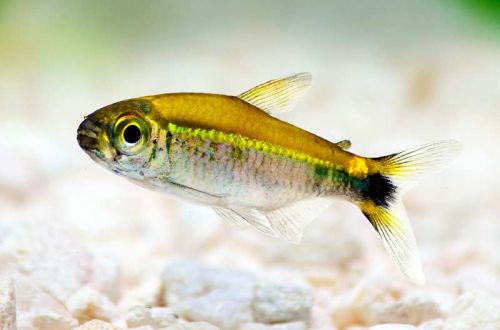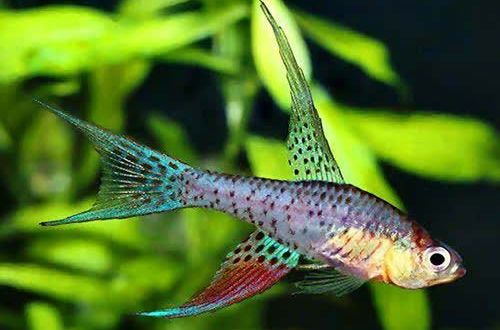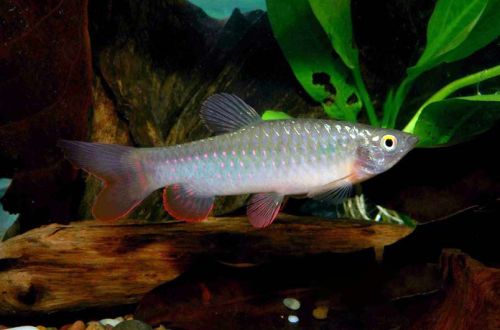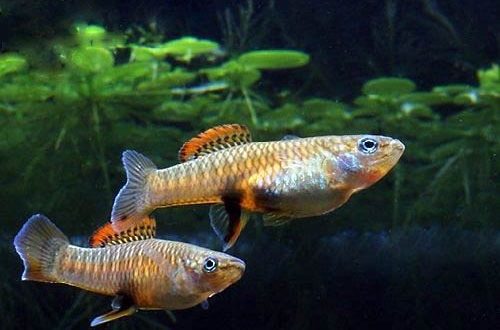
green neon
Green neon or Green neon tetra, scientific name Hemigrammus hyanuary, belongs to the Characidae family (Characinidae). The fish is native to South America. The natural habitat extends over vast expanses of the upper and middle Amazon basin. Occurs in areas of rivers and streams with a slow flow, floodplain lakes.

Contents
Description
Adults reach a length of about 4 cm. Outwardly, it resembles a Tetra-flashlight, but it looks slimmer, and there are greenish tints in the color, which appear most contrastingly along the lateral line. The body pattern is monochromatic, with the exception of a large black spot located on the caudal fin. The spot is bordered by white strokes. The same light stroke can appear on the edge of the anal fin.
Behavior and Compatibility
Peaceful schooling fish. In small aquariums, the Green Neon will not be able to compete for food with larger and more mobile species, so fish of similar size and temperament should be purchased as neighbors.
Good compatibility is achieved with Rhodostomus, most Tetras, Apistograms, Cribensis, Corydoras, small Chainmail catfish, for example, Otocinclus and others.
Brief information:
- The volume of the aquarium – from 70 liters.
- Temperature – 23-27°C
- Value pH — 6.0–7.5
- Water hardness – 5–15 dGH
- Substrate type – any
- Lighting is weak
- Brackish water – no
- Water movement is weak
- The size of the fish is about 4 cm.
- Food – any food
- Temperament – peaceful active fish
- Keeping in a flock of 6-8 individuals
Maintenance and care, arrangement of aquariums
The optimal size of the aquarium for a flock of 6-8 individuals starts from 70 liters. The decor is simple. It is recommended to use a sandy substrate on which natural driftwood and a layer of leaves of some trees are placed. Aquatic plants are optional. The lighting is subdued, so when choosing plants, shade-loving species should be preferred.
It is important to provide a mild acidic water environment. It has been noted that under alkaline conditions, the Green Neon Tetra loses its color, and in some cases a negative effect on the health of the fish is possible.
Aquarium maintenance is standard and consists of at least the following procedures: weekly replacement of part of the water with fresh water, removal of organic waste and equipment maintenance.
Food
Undemanding to the diet. Will accept most popular dry, frozen and live foods of suitable size.
Breeding / breeding
In favorable conditions, the appearance of offspring is possible in a common aquarium. However, given the lack of parental care, it is advisable to breed in a separate tank.
A spawning aquarium should be equipped with a simple airlift filter to avoid strong currents and accidental suction of eggs and fry into the filter system. The lighting is dim. At the bottom, there is a layer of small-leaved stunted plants or a special substrate that allows you to save caviar from predation by adult fish.
The stimulus for spawning is a protein-rich diet. Spawning usually occurs in the morning hours. Fish randomly scatter their eggs all over the bottom. As soon as eggs are found, adult fish should be transferred back to the main tank.
The incubation period is 24-36 hours. The fry that have appeared remain in place and feed on the remnants of the yolk sac. They begin to swim freely after 3-4 days. Feed with specialized food for fish fry (powders, suspensions, etc.), as well as live foods such as ciliates and Artemia nauplii.





